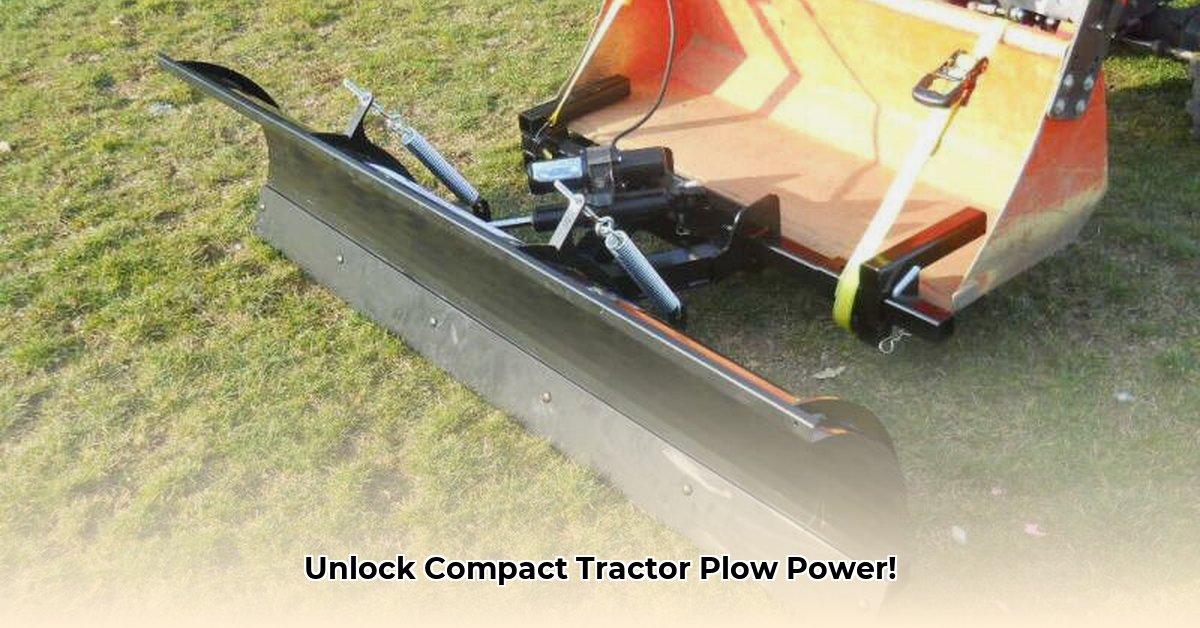
Choosing the Right Plow: Matching the Tool to the Job
Selecting the ideal plow for your compact tractor hinges on several key factors. Understanding your soil type is paramount. Heavy clay soils demand a more robust plow than lighter, sandier soils. The size of your land dictates the plow's width; a larger area benefits from a wider plow to maximize efficiency.
For more detailed information on selecting the right plow, check out this helpful guide: Compact Tractor Plows.
Crucially, consider your tractor's horsepower. Attempting to pull a plow exceeding your tractor's capacity risks damage to both the tractor and the plow itself. The type of tillage desired plays a significant role. Moldboard plows excel at deep tillage, completely inverting the soil. For lighter tasks or rocky soil, a disc plow, slicing through the soil without inversion, is preferable. Finally, budget constraints inevitably influence the selection process, with plows varying widely in price.
Understanding Your Plow Options: A Look at Different Types
Several plow types are compatible with compact tractors, each designed for specific applications.
Moldboard Plows: These are known for their deep tillage capabilities, completely inverting the soil and burying weed residue. This results in excellent aeration and seedbed preparation, making them suitable for various crops. However, they are less ideal for rocky or extremely hard-packed soil.
Disc Plows: Ideal for challenging soil conditions like heavy clay or rocky soil, disc plows slice and cut through the earth. While they don't invert the soil as comprehensively as moldboard plows, they effectively break up compacted soil and prepare it for planting.
Chisel Plows: Designed for breaking up compacted subsoil without complete soil inversion, chisel plows create vertical channels enhancing drainage and aeration. They are less demanding on the tractor and align with conservation tillage practices.
Hitching Up Your Plow: A Step-by-Step Guide
Correctly attaching your plow is critical for both safety and operational effectiveness. Follow these steps:
Prioritize Safety: Always ensure your tractor is on level ground, the engine is off, and the parking brake is engaged before attaching any implement.
Engage Three-Point Hitch: Activate your tractor's three-point hitch, the crucial link between your tractor and plow.
Align and Connect: Precisely align the plow's hitch pins with the tractor's lift arms, taking your time to ensure a perfect fit.
Securely Fasten Pins: Insert and firmly secure the hitch pins. Double-check their locking mechanism to prevent accidents.
Test the Connection: Raise the plow slightly using the three-point hitch to confirm correct connection and functionality. If there is any binding, address the issue before proceeding.
Gently Lower: Slowly lower the plow to the ground, ensuring a smooth descent.
Fine-Tuning Your Plow: Adjustment and Maintenance for Optimal Performance
Achieving optimal performance requires attention to adjustment and maintenance. The tilling depth significantly impacts soil preparation and tractor strain. Adjust the plow's depth wheel to strike the balance between thorough soil preparation and minimizing stress on the tractor. Inadequate depth will result in poor seedbeds and wasted effort.
Regular maintenance is essential for longevity and efficient operation. Lubricate moving parts, protecting against wear and tear. Regularly inspect the plow for damage, paying close attention to the plowshares, which require sharpening for optimal cutting efficiency.
Weighing the Pros and Cons: Is a Plow Right for You?
Before investing in a plow, consider its advantages and disadvantages:
| Feature | Pros | Cons |
|---|---|---|
| Soil Preparation | Creates a fine seedbed, excellent weed control | Can be time-consuming, especially for larger areas |
| Soil Health | Improves soil aeration, drainage, and water retention | Potential for soil erosion if not managed properly |
| Cost | Relatively affordable upfront cost | Requires regular maintenance and potential repair costs |
| Efficiency | Highly efficient for smaller areas | Not suitable for very large-scale farming operations |
Tips for Efficient Tilling: Getting the Most from Your Plow
Strategic Planning: Plan your passes to avoid overlaps, preventing wasted fuel and uneven tillage. Optimize your route for maximum efficiency and minimal passes.
Speed Control: Maintain an appropriate speed to ensure consistent and thorough soil preparation. Excessive speed compromises soil quality.
Work with Terrain: Adapt your plowing technique to the land's contours. Following the natural slopes minimizes soil disruption and plow damage.
Adaptability: Observe soil responses and adjust settings to maintain consistent tillage effectiveness.
Key Takeaways
- Choosing the right plow depends on soil type, land size, tractor horsepower, and budget.
- Proper attachment and maintenance are crucial for safe and efficient operation.
- Regular inspection and sharpening of plowshares significantly improve performance and longevity.